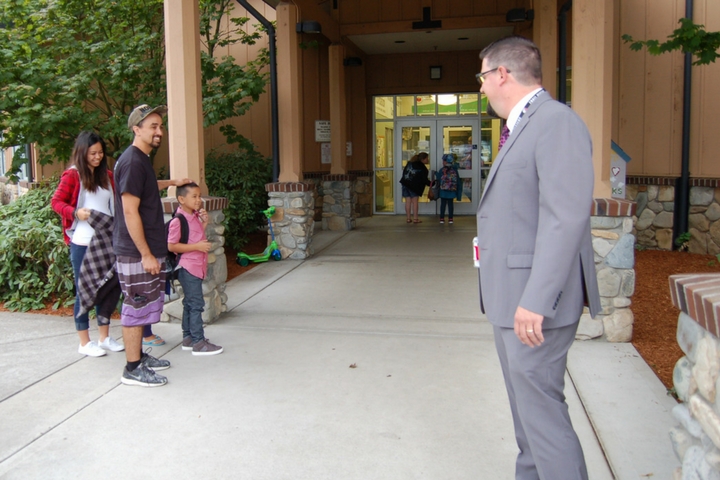
Principal Matthew Fechter greets Fruit Valley student Zayden Richardson and family on the first day of school.
Attendance, chronic absenteeism focus of schools, district
Touch Khieu admits that it can be hard to get up and go to school, even for a fourth-grader. But he has a message for himself and his classmates: “Get up or else we won’t have time to learn. ’Cause learning gets you to college, right? I would say, to anybody, to get up out of bed, get dressed and go to school. Because school is learning.”
Touch and his brother are planning to attend Fruit Valley Community Learning Center every day this school year. They aren’t alone in placing a laser focus on attendance. The entire school is making it a priority, said Principal Matthew Fechter. All day, every day. It’s the mantra echoed in daily announcements, monthly assemblies, newsletters, posters and incentives when the goal is met.
Fruit Valley’s initial goal was 90 percent. But the students and staff wanted to reach higher. Their new daily attendance goal edged upward to 95 percent. As of Sept. 27, the Fruit Valley Panthers had met or exceeded that threshold 11 times.
Every staff member at Fruit Valley is engaged in the effort, with a core group meeting weekly to identify reasons for tardies and absences and reach out to families. “Sometimes it means a phone call. Sometimes it means the principal shows up at your door and finds out what’s going on. But if we do that in a proactive manner, then it’s not a confrontation. It’s just, ‘What can we do to help you?’ and how do we support everybody?” explained Fechter.
If good attendance seems elemental to academic success, well, that’s because it is. “Poor attendance is one of the biggest barriers to success in school. If you’re not here, you don’t get access to the learning. And then when you do come back, you have to catch up,” Fechter said.
What’s less well-known are the effects of chronic absenteeism, which factors in both excused and unexcused absences. A student who misses 18 days per school year—for illness, vacations, health appointments or any other reason—falls under that definition. And while 18 may sound like an excessive number of absences, it works out to just two days every month during the nine-month school year.
The impact can reach beyond individual students, said Trish Piliado, a former teacher who now serves as the director of the district’s student welfare and attendance department. “I would have kids out of class because they were sick, or for vacations. Students would go get their hair done. Some would go spend the day with a parent because they were off work that day. Having five, 10 kids out of class at a time because of all these different issues really affects the learning environment, and we can’t do some of the cooperative learning that we’re trying to do. The teacher has a hard time moving forward with the curriculum and content because they have to do a lot of reteaching.”
AmeriCorps/VISTA member Charles Marentes is working with the district’s student welfare and attendance department to address the problem of chronic absenteeism and its long-term effects. “Only 17 percent of chronically absent kindergartners and first-graders are likely to read at grade level by third grade,” said Marentes, pointing to current research. “In sixth grade, it’s an early indicator that the student won’t graduate high school or graduate on time. By ninth grade, it indicates that the student is very likely to drop out.”
Piliado said that VPS’ attendance rates are on par with the state of Washington but acknowledged that the district “has some work to do to reach its goal” of 90 percent of students attending school 90 percent of the time by the year 2020.
That work includes a new prize patrol that visits classes with perfect or near-perfect attendance to reward the students and staff and help build the school’s attendance-focused culture. New attendance-themed accounts on Facebook, Twitter and Instagram are sharing news, tips and encouragement. Parent also now receive automated emails regarding their children’s attendance and can excuse absences simply by replying to the email.
And while there are times when tardies and absences are warranted and unavoidable, the result is clear: Time spent out of school means missed learning opportunities. This reality of absences isn’t lost on students.
Said Fruit Valley fifth-grader Keira Klein, “I would be kinda sad, because I’m missing school and learning.”
Schools share attendance successes on Twitter
Keep it up Panthers! 11 of 20 school days with 95% attendance #attendancematters pic.twitter.com/y1WGjdkQUA
— Mr. Fechter (@MrFechter) September 27, 2017
#VPS prize patrol at Ms. Langleys class at McLoughlin MS on Friday morning! #attendancematters #youmatter #attendanceawarenessmonth pic.twitter.com/aj6EMQBKZg
— VPS Attendance (@Vpsattendance) September 25, 2017
We had 597 students with PERFECT attendance in September. How about that, @Vpsattendance? Not too bad at all, but we can always get better!
— Luke LeCount (@lukelecount) October 4, 2017
Our Hough Hawks are really taking attendance seriously! Wonder how far these apples will travel by the 29th? pic.twitter.com/mvudrKUx02
— Hough FCRC (@FcrcHough) September 19, 2017
